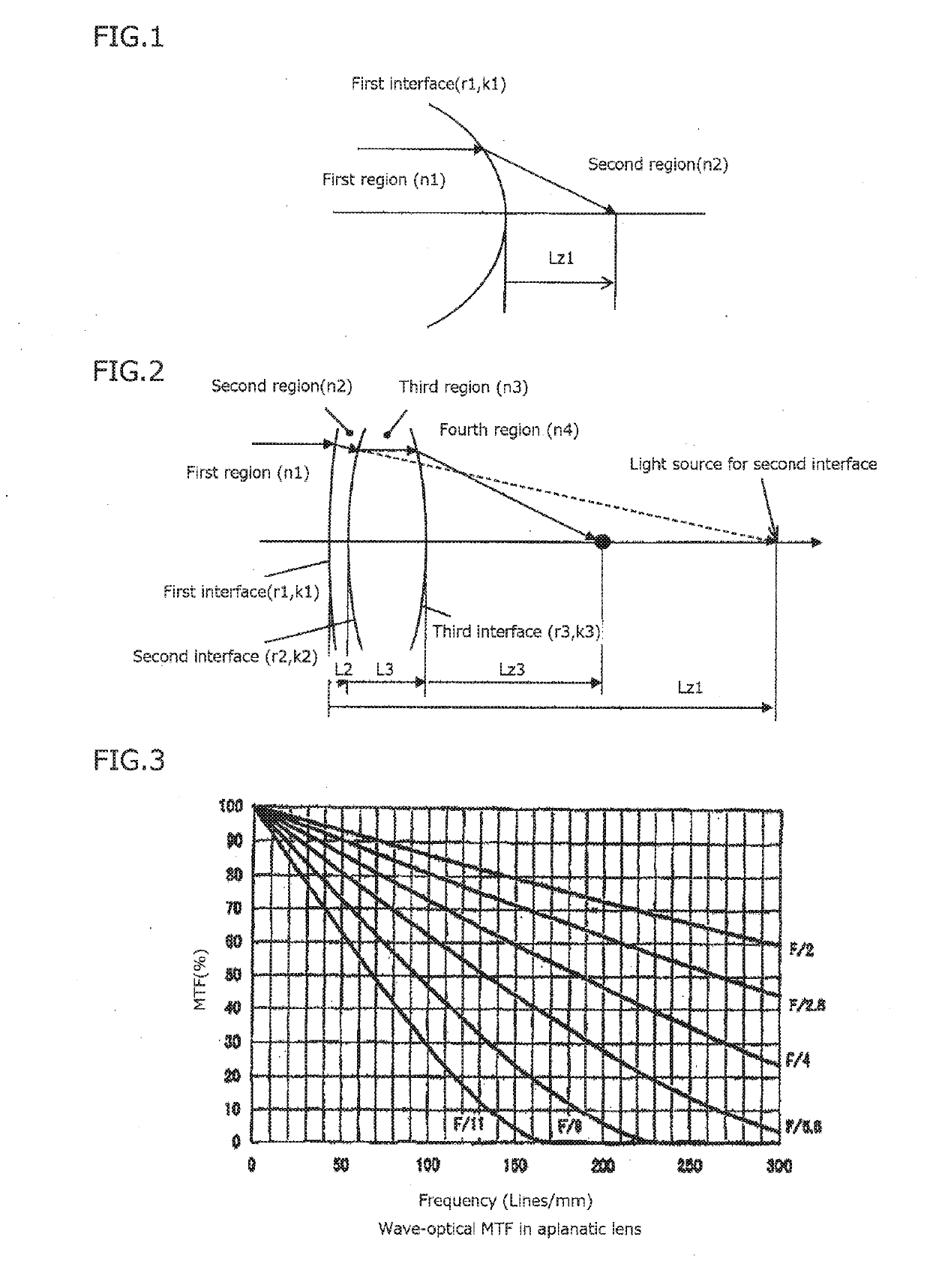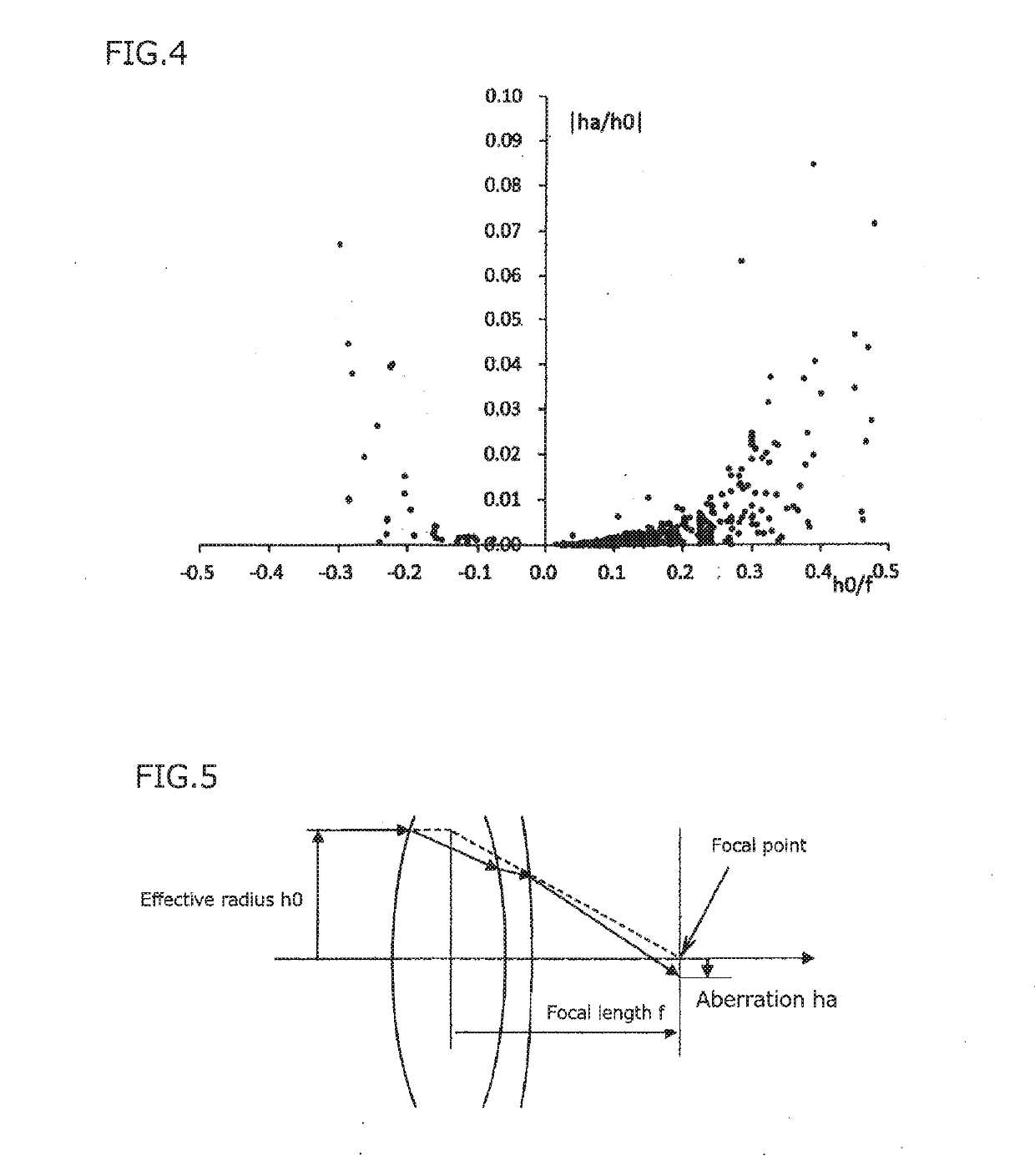Aspherical cemented lens
- Summary
- Abstract
- Description
- Claims
- Application Information
AI Technical Summary
Benefits of technology
Problems solved by technology
Method used
Image
Examples
embodiment 1
[0062]FIG. 8(a) shows an ACC lens using acrylic (PMMA) and polycarbonate (PC), which are most commonly used as optical materials of resin, and FIGS. 8(b) and 8(c) show the structures of an achromatic lens and a precise aspherical achromatic lens manufactured by Edmund Optics as comparative examples. Tables 1 to 3 show specifications of the above mentioned lenses. The first region and the fourth region are air (n1=n4=1); the focal length f=25 mm, and the diameter of the light flux incident on the first interface is 22.5 mm. For the refractive indices of PMMA and PC, the calculation formula of RefractiveIndex.INFO (http: / / refractiveindex.info) was used. In Table 3, q4 to q14 are higher order aspherical coefficients.
TABLE 1The present invention (ACC lens)Region or Interface123MaterialAirPCPMMADistance (Thickness)212r Radius of Curvature112.54166256207918.0039659403808−12.1844186844845kConic Constant−0.398174809453036−0.884692562055045−2.22186974427219q4 4th Coefficientq6 6th Coefficien...
embodiment 2
[0066]In the aspheric lens, it is known that coma aberration appears when the incident light flux is tilted from the optical axis. Although coma aberration appears also in the ACC lens of the present invention, unlike the aspheric lens using a high order aspheric coefficient and having high convergence, since the shape of the aspheric surface of the ACC lens is simple, it becomes clean coma aberration (substantially in accordance with theory). If coma aberration exists, it seems to be a defect in general because it draws a large tail, but it will be an advantage when used as follows.
[0067]In Embodiment 2, two ACC lenses of the same configuration are used, and a relay lens is configured by symmetrically arranging them in a manner that the light flux between the two ACC lenses be parallel to the optical axis. FIG. 10(a) shows a configuration of a relay lens in which two ACC lenses are arranged symmetrically, and FIG. 10(b) shows a configuration of a commercially available achromatic r...
embodiment 3
[0071]Embodiment 3 shows another configuration of the relay lens. In the Embodiment 2, the case where all the interfaces of the two ACC lenses are aspherical is shown. In the Embodiment 3, as shown in FIG. 12, interfaces (the first interface and the second interface in FIG. 8(a)) other than the outermost surface of the two ACC lenses (the incident surface and the exit surfaces as a relay lens) are spherical surfaces. In this case, the light flux incident on the exit surface is not completely parallel to the optical axis, so that the conic constants k3 of the incident surface and the exit surface are modified. In case that the light flux is not necessarily converged completely to a single point, even though the interfaces other than the incident surface and the exit surface of the two ACC lenses constituting the relay lens are formed into spherical surfaces, it is possible to obtain the same characteristics as those of the ACC lens in which all interfaces are aspherical including the...
PUM
 Login to View More
Login to View More Abstract
Description
Claims
Application Information
 Login to View More
Login to View More - R&D
- Intellectual Property
- Life Sciences
- Materials
- Tech Scout
- Unparalleled Data Quality
- Higher Quality Content
- 60% Fewer Hallucinations
Browse by: Latest US Patents, China's latest patents, Technical Efficacy Thesaurus, Application Domain, Technology Topic, Popular Technical Reports.
© 2025 PatSnap. All rights reserved.Legal|Privacy policy|Modern Slavery Act Transparency Statement|Sitemap|About US| Contact US: help@patsnap.com



